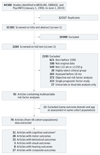Prognostic Factors for Poor Cognitive Development in Children Born Very Preterm or With Very Low Birth Weight: A Systematic Review
- PMID: 26457641
- PMCID: PMC5122448
- DOI: 10.1001/jamapediatrics.2015.2175
Prognostic Factors for Poor Cognitive Development in Children Born Very Preterm or With Very Low Birth Weight: A Systematic Review
Abstract
Importance: Cognitive delay is the most common form of impairment among children born very preterm (VPT) at 32 weeks or less or with very low birth weight (VLBW) of 1250 g or less. It is important to identify factors that are robust predictors of long-term outcome because the ability to predict future prognosis will assist in health care and educational service planning and provision.
Objective: To identify prognostic factors for poor cognitive development in children born VPT or with VLBW.
Evidence review: A systematic review was conducted using MEDLINE, EMBASE, and PyscINFO databases to identify studies published between January 1, 1990, and June 1, 2014, reporting multivariable prediction models for neurodevelopment in VPT or VLBW children. Thirty-one studies comprising 98 risk factor models for cognitive outcome were identified. Two independent reviewers extracted key information on study design, outcome definition, risk factor selection, model development, and reporting and conducted a risk-of-bias assessment.
Findings: There was evidence that male sex, nonwhite race/ethnicity, lower level of parental education, and lower birth weight were predictive of global cognitive impairment in children younger than 5 years. In older children, only the influence of parental education was sustained. Male sex was also predictive of language impairment in early infancy, but not in middle childhood. Gestational age was a poor predictor of cognitive outcome, probably because of a reduced discriminatory power in cohorts restricted to a narrow gestational age range. The prognostic value of neonatal brain injury was unclear; however, studies adopted mixed strategies for managing children with physical or neurosensory disability.
Conclusions and relevance: The influence of perinatal risk factors on cognitive development of VPT or VLBW children appears to diminish over time as environmental factors become more important. It is difficult to isolate cognitive outcomes from motor and neurosensory impairment, and the strategy for dealing with untestable children has implications for risk prediction.
Conflict of interest statement
Disclosures: None reported.
Figures



References
-
- Farooqi A, Hägglöf B, Sedin G, Gothefors L, Serenius F. Chronic conditions, functional limitations, and special health care needs in 10- to 12-year-old children born at 23 to 25 weeks’ gestation in the 1990s: a Swedish national prospective follow-up study. Pediatrics. 2006;118(5):e1466–e1477. doi: 10.1542/peds.2006-1070. - DOI - PubMed
-
- Marlow N, Wolke D, Bracewell MA, Samara M, EPICure Study Group Neurologic and developmental disability at six years of age after extremely preterm birth. N Engl J Med. 2005;352(1):9–19. - PubMed
-
- Anderson P, Doyle LW, Victorian Infant Collaborative Study Group Neurobehavioral outcomes of school-age children born extremely low birth weight or very preterm in the 1990s. JAMA. 2003;289(24):3264–3272. - PubMed
-
- Bhutta AT, Cleves MA, Casey PH, Cradock MM, Anand KJ. Cognitive and behavioral outcomes of school-aged children who were born preterm: a meta-analysis. JAMA. 2002;288(6):728–737. - PubMed
-
- Mulder H, Pitchford NJ, Hagger MS, Marlow N. Development of executive function and attention in preterm children: a systematic review. Dev Neuropsychol. 2009;34(4):393–421. - PubMed
Publication types
MeSH terms
Grants and funding
LinkOut - more resources
Full Text Sources
Other Literature Sources
Medical

